An Architecture for Cyborg Super-Society
Patrik Schumacher & Xuexin Duan, London 2018
Chinese Translation published in: Architectural Journal (AJ), Special Issue: The Cyborg Futures of Architecture, No.: 607, April 2009, Beijing, China
Abstract:
This paper embraces the future-open, anti-humanist sensibility of cyborgism from a societal perspective and locates the origin of the ongoing historical transformation of human identities and ways of life in the technology-induced transformation of societal communication dynamics. The evolution of language, and later of writing systems, are identified as crucial empowering engines of human productive cooperation and cultural evolution. Equally crucial for collective human self-transformation is the ever evolving construction of artificial environments. Built environments are as much a human universal as language and all societal evolution depends on them as frames within which an increasingly complex social order can emerge and evolve. They constitute an indispensable material substrate of societal evolution. These built environments do not only function as physical ordering channels but also operate as information-rich spatio-visual languages, as a form of writing. This insight opens up the project of architectural semiology as task to radically upgrade the communicative capacity of the built environment via deliberate design efforts that understand the design of built environments primarily as the design of an and eloquent text formulated by an expressive architectural language. The paper ends with a critical description of a recent academic design research project illustrating how such a semiological project can be conceived. Extrapolating from this leads the authors to speculate about a potentially far-reaching, new medium of communication and means of societal integration, facilitating a ‘cyborg super-society’.
Keywords:
superman, social order, futurism, anti-humanism, parametricism, tectonism, extended mind, parametric semiology
The digital revolution in architecture which spawned parametricism is but a part of the general computational revolution that is allowing human civilisation to progress to a new stage, a stage that is uniquely dynamic and promises unprecedented prosperity. The current breakthroughs in AI and AI-powered robotics imply an acceleration of the technological and social transformations of the human condition that are experienced as both thrilling and threatening. In the optimistic, explorative spirit with which futurism had embraced the technological take-off of the electric age one hundred years ago, parametricism now sees and seizes the positive opportunities for radical innovation of the computational age.
The integration of computational optimisation tools and robotic fabrication processes into the very DNA of architectural design methods and values is already manifest in parametricism’s most advanced stage and sub-style: Tectonism.
These innovations not only transform the architectural design and construction process but will, if parametricism/tectonism succeeds, transform all aspects of the discipline’s output, i.e. the global built environment and the world of artefacts. These architectural and urban transformations are (supposed to be) in tune with the overall societal transformations, i.e. with the comprehensive technology-induced transformation of work patterns, life-styles, as well as forms of sociality. Human culture and identity itself are thereby evolving and differentiating in as yet unpredictable ways, thus suspending our humanist conceptions of a presumably well-understood, stable human nature.

1 Circular centrifugal interior of ‘Discovery One’ in Stanley Kubrick’s 1968 movie 2001: A Space Odyssey
Our title plays on D. S. Halacy’s seminal 1965 book ‘Cyborg: Evolution of the Superman’ . Halacy defined a "cyborg" as a man who uses machines to increase his power, and considers tools in general, prosthetics, as well as mind expansion via psychic drugs, and he foresees that the human body might have to be medically transformed to survive extra-terrestrial conditions. In contrast to these preoccupations, this paper emphasises the technology-induced transformation of societal communication dynamics and how new artificial built environments have contributed and can further contribute to these progressive, transformative developments.
All of us have always already been cyborgs, leading very original, artificial lives within highly artificial man-artefact symbioses. This will involve new, unheard of social identities. The proliferation of diverse social roles, life styles and identities in contemporary society inspired Donna Haraway, in her famous Cyborg Manifesto , to conscript the figure of the cyborg as a suggestive metaphor and slogan for her post-humanist brand of feminism embracing the invention of new hybrid, non-essentializing identities.
Our paper also takes the cyborg as anti-essentialist metaphor and manifesto to point to a radical future openness. However, our manifesto is inviting architects to contribute to a radical enhancement of human societal processes via built environment innovations. The underlying insight and argument here is that the built environment is an indispensable part of societal communication processes, that the city is facilitating the emergence and operation of a collective super-brain and is thus an arena of a societal mind expansion. This thesis is in line with concepts of mind, as exemplified a.o. in Clark and Chalmer’s Extended Mind Hypothesis , that understand that “mental” processes are inherently social and in the case of homo sapiens increasingly involve external mind extension.
Becoming Human and Super-Human via Design
This paper is taking the achievements of parametricism and tectonism for granted in order to speculate further about more far-reaching potentials for architecture’s contribution to a new level of civilisation, a civilisation in which diverse forms of man-machine symbiosis might usher in an era that we might anticipate as “the era of the cyborg”. It is no contradiction that this paper is also taking Andy Clark’s thesis of humans as “natural born cyborgs” for granted as one of its premises because the new era implies a step change in what admittedly has always been an aspect of the human condition: self-transformation. Clark’s thesis emphasises brain plasticity and thus the openness of the human mind and person for artificial body and mind expansions. This implies optimism about the adaptive capacity of the human organism and psyche with respect to radically life-changing transformations.

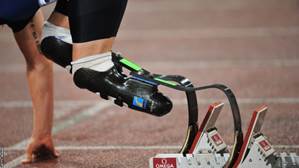
2 Electronic arm, Artist Stelarc, b. 1946 3 High performance prosthetics: Carbon Fibre running blades
The artificiality of human settlements, artefacts and dresses becomes strikingly obvious when we compare the diversity of human visual-material cultures, each with its own rich internal differentiations, with the uniformity of other primate species.
What sets human groups apart from other primates is what we might at earlier times, in the broadest sense, have called art, and what we should now refer to as design. This includes profane and sacred buildings and places, tools and other artefacts, as well all the artistry of decorative self-transformation via dress, jewellery and make-up. These practices of “artistic” self-transformation are a universal phenomenon of all human groups.


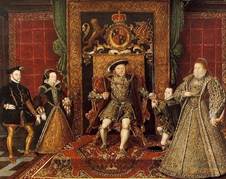
4 Group of apes. 5 King of Kuba Kingdom, Congo 6 Henry VIII
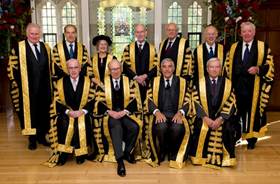
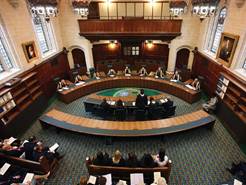
7 The 12 Justices of the UK Supreme Court 8 UK Supreme Court in session
These practices of decoration also include all buildings and artefacts, i.e. in contemporary terms they include all design disciplines. The significance of these practices, then and now, is the visual marking and thereby conspicuous differentiation of social arenas, roles and identities without which no social order can be build up or maintained. These props and marks allow dominance hierarchies, as well as more complex societal differentiations, to be institutionalized. The social order becomes independent of the continuous combative physical reestablishment of hierarchy and this way also becomes scalable.
Design is involved in the elaboration and reproduction of these vital semiological systems. Dress-codes, as well as building ornamentation and the decoration of spaces, each form a (very loose) system because we always contrast and identify when we read a place or space or a person’s style. These systems also, to some extent, connect up to form an overall system. A person’s dress style is often loosely connected to the style of his or her dwelling.
While in the old days the individual “designs” evolved gradually by tradition bound reproduction with variation, today the individual designs are indeed consciously designed. However, the overall semiological system emerged bottom up rather than by design, and today continuous to evolve without any conscious steering efforts on the collective level of the overall semiological system. This insight invites us to speculate about the possibility to raise the level of conscious, discursive steering on this level.
As Karl Marx already knew, the driving force of historical transformations are the productivity gains that accompany and indeed demand, for better or for worse, societal self-transformations within a competitive world economy. The inherent rationality of the competitive process as optimizing evolutionary process implies that change is for the better, at least for most, if not for everybody. Productivity gains are thus not only the driving force but also the ultimately life-enhancing raison d’etre of this process. Humanity as a whole enhances its material freedom, i.e. our collective capacity to “domesticate” the indifferent and often hostile physical universe and to turn it into our serviceable, pleasurable “home”. Anti-humanism or post-humanism in this context implies the rejection of an all-too fixed concept of our human nature in favour of an unprejudiced heuristics of future-openness to forms of life that defy all prior human stereotypes. What these new forms of life will be like is hardly predictable in any detail, and nobody knows where and when we might hit limits to human adaptability.
The evolutionary process of human becoming remains unpredictable in its pathways but can be trusted to deliver positive value, i.e. increasing levels of prosperity and individual freedoms, as defined by the new human subjects - the super-men in Nietzsche’s sense - that will have evolved in the process. The thesis here is that this process of becoming “superman” is only conceivable as embedded in a world-societal becoming, as part of a “cyborg super-society”. A super-man can only exist in a super-society. While there are also unknown psychological limits, whether a new super-society evolves and how it evolves depends on the societal dynamic in relation to the historical prosperity limits and potentials given by the hard conditions of what is possible technologically, and by the softer political and ideological conditions.

9 Interactive Robotic Fields, Marcel Ortmans, Ivan Subanovic, Markus Ruuskanen, I Yu, AADRL 1999/00
The emphasis here, therefore, will be placed not on speculating about a new human subjectivity or new personality types but instead on new patterns of social interaction and a new social order with new social processes and dynamics in which, very broadly and abstractly anticipated, intelligent responsive environments will join the social process, and individuated parts of it will potentially even join society itself, understood as communication process. We can imagine that intelligent, learning robotic environments to be accepted as consociates, i.e. as unique members of society.
This emphasis on the societal process and social order rather than on technology or subjectivity, is motivated by architecture’s and urbanism’s unique perspective and contribution to the evolution of civilisation, namely via its core competency that is the spatial ordering of social processes. It is a crucial fact of human becoming that the expanded social order of all human societies evolved on the basis of artificial built environments that deliver the necessary cross-generationally stable and accruable material substrate of societal evolution. This dependency still holds: Societal evolution is still supported by architectural and urban evolution.
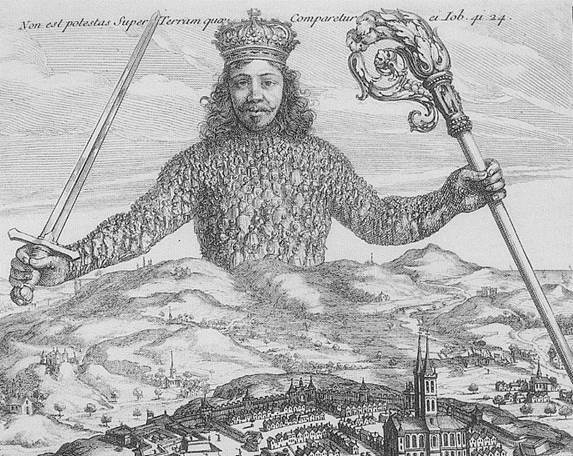
10 Frontispiece of Thomas Hobbes’ “Leviathan”, by Abraham Bosse, with creative input from Thomas Hobbes, 1651. The social body is depicted together with its architectural embodiment.
The emphasis on social order in relation to the advance of civilisation is also merited independently of our specific disciplinary perspective. The dynamism and transformative agency of human progress is located in the productive and creative power of human cooperation via the division of labour, rather than at the level of individuals’ capacities. To be sure, these capacities matter too, as given constraints. However, all the radical transformations of the human condition from the stone-age hunter and gatherer bands to our current single, integrated world society happened on the basis of virtually unchanged biological organisms. Those individual cognitive enhancements that make a difference between an ancient hunter and a contemporary world citizen are soft-ware rather than hard-ware based, i.e. due to culturally transmitted language, knowledge and learning capacities. More powerful than these individually downloaded capacity enhancements is the empowerment through cooperation within a single global mega-network that embodies what we might call “global swarm intelligence”, articulated into various discourses and also including the contributions of “organisational intelligences”, i.e. of all the organized social systems like firms, NGOs or government agencies. World society is constituted and connected up via architectural and urban spaces, transport including aviation, the mass media and the internet that allows everybody to communicate with everybody else within seconds. Architecture and design play an indispensable part in facilitating these arenas and interfaces of the global collective intelligence, including all web-based communications via our graphic and web-design colleagues.
Social communication and cooperation is the crucial factor for both the epistemic and productive powers of mankind. Expanded communication implies both expanded markets and expanded discourses, allowing for the division of labour and cooperation on a new level of productivity, inventiveness and rationality. Scale matters. A larger and more integrated society allows for a more intricate, fine-grained division of labour and thus also for increases in per capita income. This insight about the positive prosperity effect of expanded markets via a thereby intensified division of labour was already stated explicitly in Adam Smith’s 1776 treatise ‘Wealth of Nations’ .
Communication is also crucially involved in all advanced forms of cognition, reasoning and knowledge production. Language, a uniquely human evolutionary advance, is itself a social achievement, and a crucial prerequisite of all human thinking and reasoning. Languages co-evolved with societal evolution. As Ludwig Wittgenstein demonstrated, there can be no such thing as a private language . Languages are like empowering software packages that run on our brain’s hardware. As Daniel Dennett poignantly stated: You can’t do much thinking with your bare brain . 20th Century philosophy is defined by the ‘linguistic turn’ which established the philosophy of language as ‘first philosophy’, dethroning epistemology and ontology respectively.
Languages and New Modes of Communication
Human language is, in contrast to all animal communication and signalling systems, uniquely empowered due to the combinatorial explosion of expressive power delivered by grammar. Only human languages possess grammar.
It is said that it was the unique evolutionary advance of grammar-based language that opened up a new evolutionary take-off, indeed a whole new type of evolution, namely cultural evolution. We are not disputing this but we must emphasise that verbal language by itself was not sufficient. Indeed, as stated above, artificial built environments were an equally indispensable, constitutive condition and ingredient of any cultural evolution, due to their material endurance, due to their ability to be accrued and modified, as well as due to their capacity to structure and stabilize a social order on ever larger scales. Human languages co-evolved with the spatial order of human settlement structures that distinguish, distribute and connect social activities, roles and status types. The artificial built environments themselves constitute a spatio-visual language, and thus evolved with a double functionality, as physical organisation and spatio-visual codification of the social order. The same double function applies to tools and the world of artefacts in general, especially with respect to clothing. The latter in particular, as dress code, constitutes a crucial visual language without which no extended social order is or would have been possible. Architecture, artefacts, and dress are human invariants. There are no known human life forms without these ingredients and they still constitute indispensable arenas of societal evolution. The reproduction and indeed continuous innovation of these essential arenas is the responsibility of the design disciplines. Theoretically there can now be a substitution of this communication function via electronic tags that would reveal information about the tagged person (or space) but this would require our identities to be made explicit. This would be rather different from the intuitive play with affiliations, contrasts, hints and deliberate ambiguities that aesthetic communication affords. Also, there is only so much text-based information that can be fed through via PDA or similar devices. In contrast, the built environment and world of artefacts and dress constitute a 360 degree interface of communication that addresses all the senses.

11 Painting depicting social gathering, "Five Dynasty" (907-960 AD).

12 Paris Social Scene, French School, 18th Century
All design is communication. This slogan recognizes the importance of these design domains and their understanding as language domains for societal communication and thus social order. However, the various languages of the built environment, artefacts and dress are still rather crude, fragmented, and full of visual noise, and most crucially they are mostly simple signalling systems with only the most rudimentary beginnings of grammar. What thus transpires here is a fantastic and yet totally untapped opportunity for momentous and potentially impactful innovation. If the built environment operates like a language then it can be made to operate much more so, and much more effectively.
This insight motivates the research programme ‘Agent-based Parametric Semiology’. Parametric semiology implies that it is the formal repertoire of parametricism, and indeed of tectonism, that serves as palette with which to design the spatio-visual language. The qualification agent-based indicates that this research project involves a simulation capacity that tests the social ordering efficacy of the designed semiological system. Here, however, rather than presenting the first results of this research, our agenda is speculative, i.e. speculation about the radical transformative potential of the semiological project for the built environment and indeed human civilisation. What we are envisioning is the radical expansion and enhancement spatio-visual communication, if not the opening up of a whole new mode of communication.
A few hints about the transformative impact of prior expansions of human communication might stimulate our imagination and anticipation here. After the original evolutionary take-off innovation of verbal human language, it was the evolution of writing systems that had hugely empowering consequences for human civilisations. In fact, what we usually describe as the first human “civilisations” in contrast to earlier tribal groups, are indeed all, and by necessity, writing-based, literary civilisations. We should also note here that the level of societal advancement we call “civilisation” also implies, without exception, the emergence of cities. All civilisations are literary, urban civilisations. Printing marked yet another momentous step, inaugurating what Marshall McLuhan termed the Gutenberg Galaxy . The media theorist McLuhan remains a classic reference for all Cyborg related inquiries. He sees media as epoch-making, but perhaps places too much emphasis on media-induced shifts in human cognition and subjectivity as a mechanism of new media’s societal impact. Prime attention should rather be given to the new, extended forms of social organisation that become possible. However, his slogan “the medium is the message” remains pertinent.
This resonates with Jacques Derrida’s reflection on the decisive role of the medium of writing and its irreducible contribution, over and above speech, for philosophy. There is no way that elaborate discourses on morality, politics, law, economy, architecture etc. could have emerged without writing, on the basis of an oral culture only. Indeed, as the sociologist Niklas Luhmann emphasizes, these modern discourses which became crucial historical accelerators, quickly became extensive, specialised, critical literatures which could not have come into existence without printing which massively increased the participation and turn-over in these discourses. In fact, discourses in the modern sense could not have emerged on the basis of writing alone, i.e. via hand-copied manuscripts.
Printing was prima facie a momentous empowerment of writing rather than a new, sui generis medium of communication. However, the mass dissemination of written texts also triggered a qualitative shift in both the texts themselves and transformed the societal role and impact of written communication. Modernity was indeed Gutenberg’s galaxy. An elaborate philosophical discourse as exemplified in Immanuel Kant’s 1781 Critique of Pure Reason, a systematically ordered, thousand page treatise that fast spawned a wave of intense philosophical work known as German Idealism, is unimaginable without printing, both with respect to its conditions of production, based on the availability of an extensive library, and with respect to its wide reception.
Similarly to print, radio and television are dissemination engines, here for speech, face-to-face communication, and theatre, rather than an altogether new medium as speech itself in relation to facial and gestural expressions, or as writing, and indeed drawing, over and above speech.
The rather remarkable fact that writing and reading is possible with nearly the same speed as speaking and listening testifies to the enormous plasticity of the human brain and to its receptiveness to new forms of software delivery and new operational modi. Musical notation brings home this point too, as well as mathematical notations. These also show that writing systems do not have to go through silent, inward speech as alphabetical writing seems to do, at least for beginners. With sufficient training, all forms of reading, like listening to speech, develop from a process of concentrated deciphering to something more akin to effortless perceptual absorption. Finally braille, the script for the blind, demonstrates that the tactile channel might be utilized, with its own arbitrary tactile code, and with equal proficiency as the auditory and visual channels. The density of information transfer seems to be more or less undiminished, once subjects are sufficiently trained up.
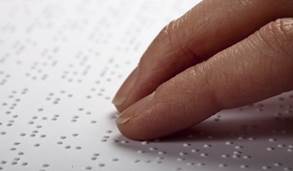

13 Braille embossed tactile writing system for the blind. 14 Tactile information embedded in public navigation surfaces.
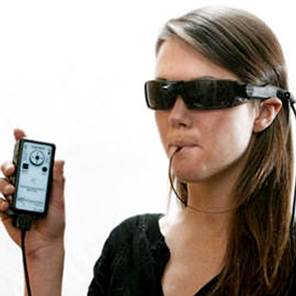
15 BrainPort, developed by neuroscientists at Wisconsin based Wicab. Inc. A pair of sunglasses wired to an electric "lollipop" helps the visually impaired regain optical sensations via the tongue.
The underlying brain plasticity and learning capacity is also strikingly evidenced by recent technologies for the effective substitution of vision for the blind. A matrix of differential stimulations, transcoded from the feeds from a head mounted camera, is being delivered to the tongue, or alternatively to an area of skin of the subject’s back, substituting for the retina of eye-based vision. An area of about 3 x 3 cm of densely packed nerves on the tongue surface is stimulated by electrodes transcoding light-dark into strong-weak impulse.
The subject gets accustomed to how the variations in the stimulation are systematically related to variations in her surroundings as well as her scanning head movements and locomotion, and constructs a vision-like intuitive, objectifying new form of perception.
Returning to our natural perceptual channels, we know that auditory perception can also deliver a degree of space perception and spatial orientation. However, as with speech itself, the auditory channel can also been used for language-like information transmission, like systems of sound alarms, or for a kind of encoded writing as in the Morse code which can be represented in sequences of short and long tones or dots and dashes. Braille-like dot and dash patters are also being used within the build environment to communicate useful information to aid the navigation of the blind within public spaces using the tactile channel.
Speculation: The Designed Environment as Total Communication
These reflections bring us to the point where we can start to speculate about the gradual but ultimately comprehensive transformation and utilisation of the built environment and the world of artefacts, i.e. the totality of the phenomenal world that surrounds us, into a continuous, densely articulated communication that addresses all perceptual channels or senses, i.e. vision, touch, hearing, taste, smell, thermoception, equilibrioception, and proprioception, to be designed by the self-organized, bottom-up concert of all design disciplines including urban design, architecture as well as landscape, interior, furniture, product, and fashion design, as well as graphic and web-design.
Ideally, the design of this totality of the human habitat, would, in each of its individually designed components, not only follow the style of tectonism but furthermore follow the rules of a unified semiological system. Each individual design, each individually authored urban, architectural, interior design, would be like a permanently broadcast utterance in accordance with the rules of a global, multimodal language. This unified language will not itself be designed at once but would emerge from the gradual proliferation and convergence of individual, project-specific semiological systems. The language will probably not be required in all parts of the built environment but will first spread in the most advanced, dense, complex, high performance metropolitan centres of world society. Because these are interconnected, convergence towards a single semiological system or language is likely. An architectural semiology can be expected to be motivated by indexes, i.e. derive from the forms that are selected to fulfil the physical part of the social function to be accommodated and expressed. While the function of communicating its purpose adds additional motivation and constraints, this implies that the forms that will end up as signifiers of their function will be rather a limited set, constraint to those forms that can indeed physically fulfil those functions, rather than being selected arbitrarily as in verbal languages. This fact, together with the fact that the overall meaning domain is very much restricted, eases the convergence process. This global language will probably still have many regional dialects and only a few large and complex institutions will probably exploit the full elaborateness of its vocabulary and grammar.
What is, under current socio-economic and political conditions and also in future, surely unimaginable is that there could be a centrally devised and prescribed spatio-visual language in analogy to the system of traffic signs for all designs from urban design to product and web design. Such an expectation is unrealistic even only for urban design, as is evidenced by the forced retreat of urban planning in the face of the dynamism and complexity of the urbanisation process and of the social process in general. However, the analogy of the traffic sign system is instructive. It can serve as a simple model for the generalized semiological project we envision. This system makes a complex and dense urban circulation possible, giving a rule-based ordering matrix to structure and facilitate the coordinated movements of multiple distinct sets of participants which the system distinguishes, including pedestrians, bicycles, cars, taxis, trucks, buses, and trams. The registers of semiological articulation are mostly graphic and include street markings using various line types, line colours, arrows and hatchings, as well as vertically erect signage plates and traffic lights, placed both above and next to movement spaces. The signs are built up by means of a grammar that allows the composition of complex signs from multiple sign radicals that thereby compose a complex meaning. The domain of meanings is constrained to the concerns of traffic regulations and contains prohibitions, commands, warnings and guiding information facilitating navigation. Most signs are deictic in the sense of referring to the immediate context. STOP means stop here. The design of the signs does not only follow semiological prerogatives but evidently must also satisfy the phenomenological concerns of conspicuity and perceptual tractability.
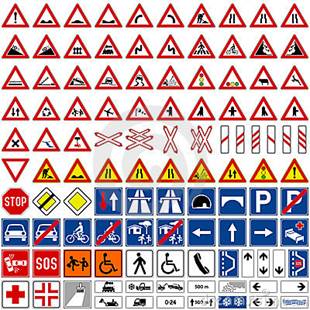
16 Traffic sign system: A grammar based system that distinguishes Prohibitions, warnings, commands, guiding information.
All these features, the general function of facilitating the self-ordering of social processes, the concern with phenomenology, the deictic context relatedness, the distinction of status groups, and the aspect of (here mostly non-legal) normative rules of access and behaviour are also determinative of the generalized semiological system envisioned here, including a constrained domain of the signified. This domain focusses on the immediate concerns of spatial navigation and on designating the social interaction type offered by each respective zone or space, each with its respective role expectations and protocols of interaction. In addition this language informs users about who’s space it is or who to expect in the zone or space in question. Thus there are three primary types of information to be conveyed which we term locational, functionial, and social information respectively.
The task of facilitating navigation within the built environment by means of communicating locational information, as well as the basic task of designation, is now explicitly taken care of only by wayfinding and signage design, as an add-on system of graphic or written signs. The advantages of what we propose here are pragmatic: Signage systems are a crude crutch. Users have to first find the sign and this becomes increasingly difficult in a very complex visual field. Then, if it is text based, users have to read it. This takes concentration. In contrast, if the totality of the built environment becomes an immersive, 360 degree interface of communication, then much more can be taken in, and a lot of it subliminally.
The differentiation of both interaction types, i.e. types of social situation, and social types, distinguished by status, personality, affiliation, interest etc., could become rather rich and nuanced, in accordance with contemporary society.
Of course this meaning domain, the scope of what can be expressed in the language of the built environment and artefacts is much wider than in the case of the traffic sign system. However, compared with verbal language and even more so compared with writing, the scope is massively, and strategically so, restricted to the task of orienting and ordering the participants of the social interaction and communication process by means of broadly premising and framing the specific modes and contents of those communications that can then flow within these designed frames.
Architecture itself does not symbolize everything, it does not tell us stories, it must only tell us what to expect and how to act within its bounds (or in its vicinity). We need to ask and answer the question: What does the user need to know about an urban or architectural environment to be enabled to most fully utilize it, and what can an urban or architectural space communicate about itself? The answer is, as indicated above, three-fold: We expect a space to communicate its designated function, then who this space belongs to, and finally what we might expect to find beyond our current field of vision. This restriction is necessary and empowering. The failure to delimit the domain of the signified was one of the reasons why the earlier postmodernist semiology could not succeed.
The next preliminary clarification concerns the minimal unit of any meaningful architectural sign or communication. In verbal language it is the sentence that constitutes the minimal unit of communication. In any prospective architectural language only a spatially defined territory can function as such a complete sign or minimal unit of meaning. Architectural elements or motifs can only count as incomplete sign radicals that by themselves communicate nothing, but might contribute to the demarcation and characterization of a territory or place. The crossing of a demarcation or threshold implies the entering of a different place and different (potential) social situation. The spatial distinction implies a social distinction. Only a territory is a full communication, i.e. something that calls for being either accepted or rejected. Boundaries or thresholds mean that crossing over implies entry into a new social situation with new protocols of behaviour and engagement. The same applies to a change in aesthetic atmosphere. Spatial and visual differences should make a social and situational difference, in accordance with Bateson’s definition of information as ‘differences that make a difference’ .
Each territory is a communication. It communicates an invitation to participate in the framed social situation. To enter the territory implies an acceptance of its spatial communication and the act of entering thus communicates one’s willingness to participate in the respective interaction scenario. Everybody who enters is expected to adopt the behavioural rules implied. That’s the point of all signification: the coordination of behaviours facilitating cooperation. The precise characterization of the situation depends upon the orchestration of the various semiological registers that come together in the articulated territory: its position in the overall matrix of territories, its spatial shape, its tectonic and material articulation etc. The articulate territory might thus be designed according to a ‘grammar’ as a well-formed combination of sign radicals. The build-up of a spatio-visual grammar affords a momentous combinatorial enhancement of architecture’s versatility of expression. A small vocabulary might afford a vast number of different communications.
The re-foundation of architectural semiology is thus based on three premises or axioms:
1. the domain of the signified is limited to function type, social type, location type
2. the territory is the minimal unit of signification/communication
3. architectural semiology must exploit the combinatorial power of grammar
So far only the theoretical framework has been elaborated and a series of academic design studies have been conducted at various universities in recent years, including at the Architectural Association School of Architecture in London, the University of Applied Arts in Vienna and at Harvard’s Graduate School of Design in Cambridge MA.
Example: The Design of a Spatio-visual Semiological System
For our academic design research studies we chose programmes such as a university campus or a corporate campus for tech firms like google, and innovative work environments in general, as initial design research arena for the semiological project. These are the high performance arenas at the most advanced frontier of our civilisation where the new productivity potentials of our post-fordist epoch are explored and pushed forward. Architecture’s innovations must be relevant and congenial to these arenas. It is here that the complexity of social processes is most expressed, where communication is most intense and dynamic, where divers human actions and interactions are integrated in intricate patterns of cooperation rather just run in parallel. In contrast, retail or residential arenas are much simpler, and less integrated, i.e. they accommodate parallel rather than integrated lives and thus, as it were, operate by addition rather than multiplication. The next decision was to privilege interior over exterior spaces. While urban fabrics matter, it is in the interior where the most important and most intricate social interactions reside.
As example of a semiologically conceived architectural project we would like to present a recent student project developed by Yihui Wu, Lei Wang, and Yanling Xu under the guidance of Patrik Schumacher, Pierandrea Angius and Lei Zheng at the Design Research Laboratory of the Architectural Association School of Architecture in London. The semiological design research project crucially includes the design of a spatio-visual language, i.e. the design of a semiological system or system of signification, with explicit vocabulary and grammar. The particular design project is then understood as only one among many possible applications or “utterances” of the designed language.
All semiological design must proceed by means of building up two correlated systems of distinctions, the system of signifiers or symbols and the system of signifieds or meanings. This focus on system and distinction is crucial and was first emphasized by the founder of semiology, the Swiss linguist Ferdinand de Saussure. All terms are relative and acquire their meaning only in distinction and relation to the other terms. A language operates always on the basis of a total system of distinctions “in which all the elements fit together, and in which the value of any one element depends on the simultaneous coexistence of all the others” . In the design of a semiological system the distinctions in the domain of the signifiers are to be correlated with the distinctions in the meaning domain. In the case of architectural semiology the domain of the signifier is the world of architectural forms, i.e. the spaces and their defining components or properties, and the domain of the signified is the world of varied possible social situations to be accommodated. The project presented here proposes a work environment for a start-up incubator. In such buildings very many different social situations must be distinguished and therefore many different spaces must be differentially characterized. Each space within the total manifold of spaces is defined by a particular combination of aspects. The design of each individual space therefore involves a number of appropriate selections from the articulation options made available by the language via its vocabulary and grammar. The vocabulary is ordered into categories, or substitution classes, or registers of semiological encoding: location, spatial shape, boundary type, colour, material etc. These registers correspond to meaning dimensions within which the intended aspects of the social situation can thus be selected: destination vs circulation, business vs socializing, work vs meet, public vs private, allocated vs bookable etc.
The first distinction we might introduce to explain the designed system is the formal distinction between bound vs unbound spaces. To this form distinction on the signifier side corresponds, on the side of social meaning, the distinction between business spaces and leisure spaces. This formal distinction carries the further functional meaning of destination vs circulation space. Within the bounded business spaces we introduce the subsidiary distinction of convex vs concave spaces, designed to encode the social distinction between work spaces and meeting spaces.
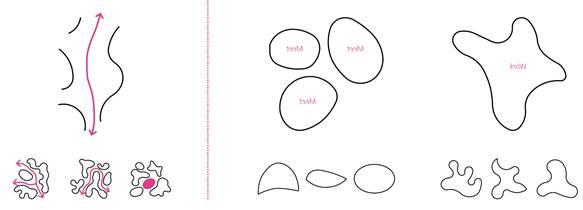
17 Dictionary of Spatio-visual vocabulary: Two hierarchically ordered distinctions in the register of spatial shape: the spatial distinction bound vs unbound signifies the social distinction business vs leisure. Within the bound spaces the spatial distinction convex vs concave signifies the social distinction meeting vs working.
The posited distinctions, both the distinction bound/unbound as well as distinction convex/concave, are rather abstract and therefore allow for a lot of variation in shape and size without thereby infringing on the distinctive meanings preserved across all the possible variations. This is indicated in the small diagrammes at the bottom. This abstractness allows for parametric variation, in line with the requirements of parametricism. We might therefore talk about “parametric semiology”.
Now we introduce two further distinctions that both cut across the previously introduced distinctions as well as cutting across each other. Both meeting and work spaces might be private, semi-private, or public, respectively represented via thick boundary, dashed boundary or thin boundary. Public work/meet areas might be WeWork-style co-working areas. Private areas belong to particular start-up companies. Colour, grey vs white, further encodes allocated vs bookable spaces. The matrix indicates that the choices offered by these distinctions are freely combinable. Of course it must be checked if all possible combinations make sense on the meaning side. If not, then restrictions on free combination must be introduced. Such restrictions or their absence, i.e. the regulation of sign-radical combinations, are determined in the grammar of the language.
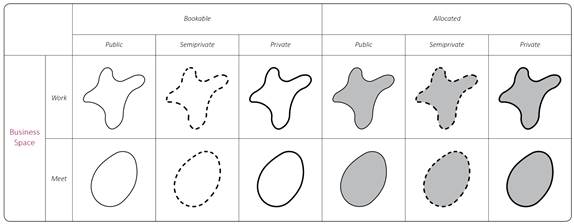
18 This matrix shows how three distinctions can combine to produce 12 different expressions.
We can see here how grammar-based languages operate by multiplication, by exploiting the proliferation of expressive power due to the power of combinatorics. The system of three distinctions offers here the expression of 12 different messages. If we would include the bound/unbound distinction in this game of combination we would arrive at 24 expressions.
Another aspect of the paradigm of parametric semiology is the readiness to consider that distinctions might be introduced not as strict dichotomies but as a gradient spectrum of options defined by two poles. Formally this can be achieved by “inbetweening” or “morphing” between the two poles of the spectrum. However, this operation makes only sense if we can meaningfully conceive of a corresponding gradient in the domain of social meaning. Within contemporary work dynamics such a spectrum of situations between a clear cut meeting situation on the one hand and a clear cut concentrated individual work situation on the other hand could indeed make sense. If we assume a gradation into 8 grades and combine these 8 choices with the two new distinctions introduced above we arrive at 96 choices offered by working with only three distinctions.
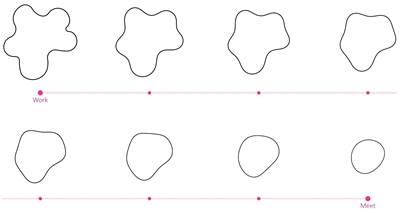
19 Parametric Semiology: The dichotomy of convex vs concave is transformed into a continuous spectrum of shapes defined between the two poles with a continuum of shapes that are more or less convex or concave.
As indicated above, the grammar of a language regulates the combination of sign-radicals into full signs as well as regulating the combination of multiple signs into a larger communication or overall text. It is therefore required to design and thus decide on the syntactic rules for combining signs and related semantic rules about how the combination of sign-radicals or signs should be read to determine the overall meaning of the combined signs. It can be expected that the downstream combination of the designed vocabulary might create problems and is thus constraining and feeding back into the design of the vocabulary. The diagrammes here test the possibility of combing work and meeting spaces and show that the convex meeting spaces can and should nestle into the concave niches provided by the working spaces. Further adjacent work spaces are expected to similarly interlock. We can thus posit the grammatical rule of nesting spaces.
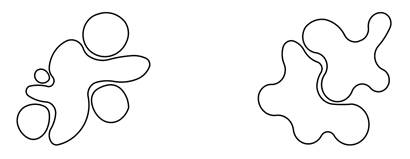
20 Grammar of nesting spaces: The vocabulary of concave and convex spaces lends itself to the organisation of efficient aggregations. Nesting also indicates that spaces belong together.
Within contemporary architecture, since deconstructivism, it is possible and often advantageous to allow for territories to overlap. As social complexity and communicative intensity increases it becomes increasingly problematic to restrict the spatial organisation of social processes to neatly separated zones. Rather than jumping from this order of zoning to a disordered condition where everything mixes everywhere, it is advantageous to allow for the determinate allocation and articulation of zones where particular social functions and their respective territories can overlap. The accommodation of this possibility is a recurring feature of parametric semiology. There is no guarantee that any given vocabulary can support the meaningful and coherent articulation of overlap conditions. The vocabulary introduced here does allow for the articulation of overlap, while maintaining a coherent system of signification. The overlap of two concave, amoeba-like work spaces might generate either a new concave work space, i.e. where two work groups might collaborate in a dedicated collaboration zone, or might generate a new convex space as shared meeting space that then conspicuously belongs to both work spaces that overlap there. The overlap between a concave work zone and a convex meeting zone generates a new convex meeting space. This can make sense when a meeting space that belongs to a particular work group is at the same time characterized as belonging to a larger meeting zone.

21 Grammar of overlap conditions: Two concave work zones generate a new concave work space which belongs to both. Alternatively they might generate and overlap in a shared convex meeting space. A Work zone and a meeting zone can only generate a new meeting space. These results make sense and are coherent with the initial definitions.
The next move is building up the complexity of the semiological system tackles the initial distinction between bound and unbound spaces. This distinction is a dichotomy which with a clear cut criterion: a bounded space is enclosed by a boundary. The unbounded space is the continuous space that flows between these bounded spaces. This criterion still holds in case of a long, meandering boundary line, as long as it eventually closes the loop. However, this distinction can be made ambiguous, and turned into an ordered spectrum distinguishing degrees of boundedness. On the one side of the spectrum the distinction is clear and crisp as bounded spaces are indeed always fully closed. However, spaces might be defined that are very similar to fully bounded spaces where the boundary loop nearly closes, but leaves a small gap. These gaps might gradually increase and the distinction between bounded and unbound spaces becomes increasingly blurred. On the meaning side this can be interpreted as follows: the distinction between business spaces for formal collaboration and spaces for socialising is getting blurred. A field that offers many such inbetween situations might be desirable and conducive for informal communication and collaboration.
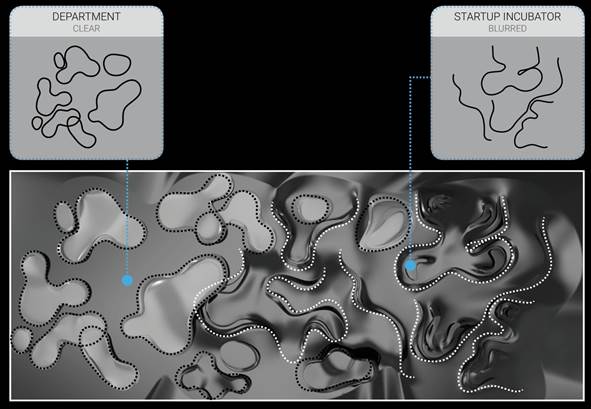
22 Gradient Field Condition: The dichotomy of bound vs unbound spaces is gradually dissolved moving from west (left) to east (right). The distinction between work and meet is being maintained as the distinction between business and socialising communication is being increasingly blurred.
The project utilizes this possibility offered by the semiological system. In particular, it does so by arranging the spaces in such a way that an east to west vector of gradual transformation emerges whereby the distinction between bound and unbound spaces which is very crisp at the western end of the space gradually dissolves as we move eastwards. This implies that the morphological encoding of the difference formal/informal business is redundantly over-coded by the locational encoding. Such redundancies are a useful option in cases where messages deserve to be reinforced because they might otherwise be overlooked or where messages are important and thus deserve emphasis via duplication. The model displays a further redundancy: the gradient from the zone with the crisp bound/unbound dichotomy to the blurred condition is once more reinforced by a gradient treatment of the contrastive colour distinction which gradually disappears as we move into the blurred condition. In turn, the ordered gradient spectrum also offers locational information and thus also operates as effective navigation aid.

23 The Field three-dimensionally articulated and furnished. The bound-unbound west-east gradient is redundantly over-coded via the gradual dissolution of the light-dark colour contrast.


24 & 25 Detailed three-dimensional articulation of the blurred end of the gradient spectrum. The boundary itself is dissolving while the distinction between working and meeting holds fast.
In the further detailing of the three dimensional articulation of the scheme the boundary lines themselves blur and turn from platform edges and walls more and more into relief-like stepping edges as we move into the blurred zone and as the closure of these lines diminishes. Thus users gain multiple local morphological clues that tell them where in the spectrum from formal to informal they are located. As the detailed model shows, the distinction between working and meeting zones can also, to some extent, be maintained in the informal, blurred zones.
Finally, the semiological system also encompasses and makes semiological use of the furniture as well as of the ceiling and lighting design. The design succeeds in reusing the correlation of the convex/concave distinction with the meet/work distinction on the furniture scale. The ability to reuse distinctions in this way is of course elegant and advantageous and makes the overall language cognitively less taxing. Also, the choice of forms has been motivated here by considerations of pragmatic social functionality. Convex tables and convex spaces make sense as meeting tables and spaces. Serendipitously, its opposite, the concave or convoluted, meandering form is viable for both work tables and work zones.

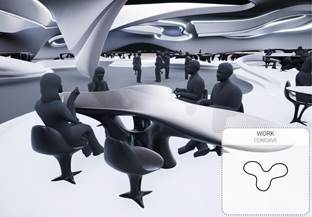
26 & 27 The distinction of meet/work via the difference convex/concave is being re-applied on the level and scale of the furniture.


28 The crisp, formal, dichotomous end the the space. 29 The blurred, informal end of the space in perspective.
This example shows that while signifiers, with respect to their communication function, can in principle be chosen arbitrarily, this is not always possible or advisable in architectural semiology. Here the domain of the signifier is indeed often pre-constrained to the range of forms that are pragmatically viable for the purposes they are to signify . What we further witnessed here is that the relative arbitrariness or degrees of freedom that exist at the outset when starting to design a semiological system become increasingly constrained by what has already been stipulated . We should expect that architectural codes, just like verbal languages, expand their vocabulary by analogical extension rather than by arbitrary invention.
This example is meant to illustrate how a relatively complex and nuanced semiological project can be step-wise elaborated on the basis of an integrated, systematic series of simple and intuitive form-function or form-meaning correlations. It serves here as initial illustrative glimpse into the ambitious, transformative project of a generalised, all-encompassing, increasingly information-rich and nuanced language of the built environment and world of artefacts.
We are living in a communication society where nearly all work has become communication work, while all physical work has been delegated to machines, and where indeed all activities are about communication. During the last 150 years channels and media of communication have proliferated starting with print media, telegraphy, moving on to telephone, radio, and television, finally via the explosive communication revolution delivered by the internet. All these advances have delivered so many crucial expansions and intensifications of social communication and thus crucially enhanced the vital integration of society, affording us new material and social freedoms via its increasing productive power. The full utilisation of the total built environment and world of artefacts as radically enriched, multi-model, intuitive medium of communication would be a fascinating and ambitious expansion of our discipline’s remit, congenial to contemporary communication society. This project could deliver a further enhancement of society’s integration and potency. Architecture could thus contribute another, unique step towards an advanced, strange, but ultimately liberating, Cyborg Super-society.
End.
D. S. Halacy, Cyborg: Evolution of the Superman, Harper and Row Publishers, New York 1965
Donna Haraway, A Cyborg Manifesto – Science, Technology and Socialist Feminism, 1985
Andy Clark & David Chalmers, The Extended Mind, 1998. Analysis 58, pp. 7-19
Andy Clark, Natural-Born Cyborgs: Minds, Technologies, and the Future of Human Intelligence, Oxford University Press, 2003
Adam Smith, An Inquiry into the Nature and Causes of the Wealth of Nations, 1776
Ludwig Wittgenstein, Philosophical Investigations, 1953
Daniel Dennett, From Bacteria to Bach and Back: The Evolution of Minds (p. 281). Penguin Books, 2017
Marshall McLuhan, The Gutenberg Galaxy: The Making of Typographic Man, 1962
Marshall McLuhan, Understanding Media: The Extensions of Man, 1964
Gregory Bateson, Steps to an Ecology of Mind, University of Chicago Press, Chicago 1972, p.459
See: Patrik Schumacher, The Autopoiesis of Architecture Vol.2 – A New Agenda of Architecture, Wiley & Sons, London 2012, sections 6.5 – 6.10
Ferdinand de Saussure, Course in General Linguistics (French: Cours de linguistique générale), Geneva 1916, p.113
More elaborate reflections of this point can be found in the chapter “Extra-Semiological Demands on Architecture’s Medial Substrate” in: Patrik Schumacher, The Autopoiesis of Architecture, Vol.2, Chapter 6.8.6
More elaborate reflections of this point can be found in the chapter “Absolute and Relative Arbitrariness” in: Patrik Schumacher, The Autopoiesis of Architecture, Vol.2, Chapter 6.9.3




























